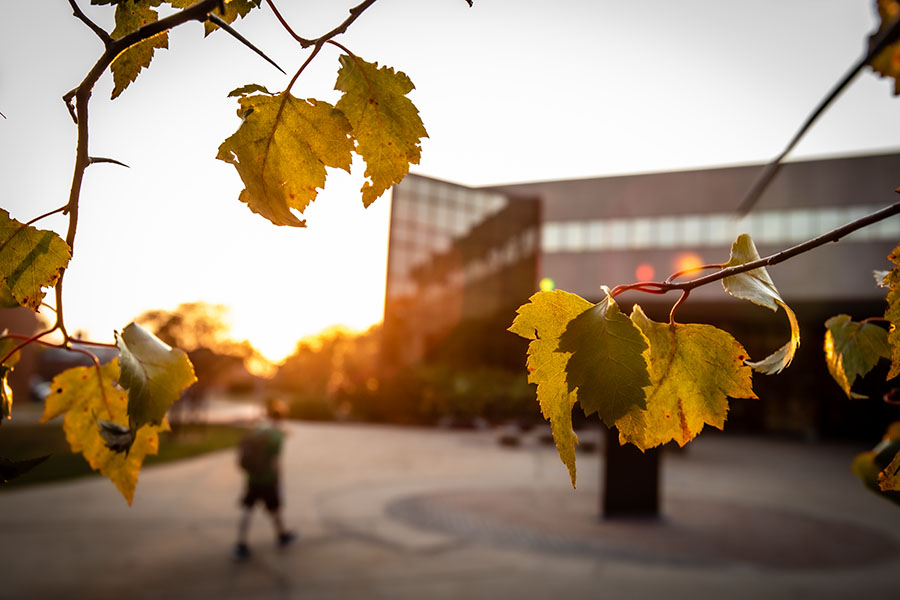Oct. 21, 2020 | By Leah Newell, communication assistant

The Missouri Arboretum, with its 160 species of trees from throughout the world, recently added a garden of poplar trees and rare Ozark chinquapin trees to its collection. (Photo by Todd Weddle/Northwest Missouri State University)
With more than 1,700 trees representing about 160 species on the Northwest Missouri State University campus, the diverse tree collection and opportunities for research are a point of pride for the institution. This fall, a new garden of poplar trees and rare Ozark chinquapin trees are furthering the Missouri Arboretum’s mission.

Northwest is one 18 universities and arboreta to plant a poplar garden this year as part of a collaborative, NSF-funded research network with North Dakota State University and ArbNet. (Submitted photo)
Northwest recently was one 18 universities and arboreta selected by North Dakota State University, in collaboration with ArbNet, to plant balsam poplar trees and their hybrid counterparts as part of a new garden-based research network funded by the National Science Foundation’s Plant Genome Research program. Forty-seven unique sets of genes and two replicates are being planted at each of the research sites throughout the country.
The goal of the project is to pair scientific research with community outreach and education. Researchers will focus on the impact genetic variation, ancestry and environment have on poplar performance across a range of habitats. Meanwhile, the outreach will concentrate on developing middle school curriculum, bringing students to the garden for hands-on data collection to illustrate the principles of adaptation and climate change.
Northwest students also are benefiting by developing research skills as they plant and measure the trees.
“(Students) can help us,” Patrick Ward, the manager of the Missouri Arboretum, said. “They can begin to understand different growth rates of the hybrids. It’s going to bring an educational aspect to the University, some hands-on experience on a research project. It produces a research area we can use for years and years.”

Laura Mott, a Northwest student employee working with the Missouri Arboretum, holds one of the Ozark chinquapin seedlings added to the campus landscape this year. (Submitted photo)
In addition, the Missouri Arboretum added Ozark chinquapin seedlings to its collection this fall. The trees were thought to be extinct after a fungus started wiping them out during the 1900s. In the early 2000s, a Missouri naturalist began searching for surviving trees and located dozens of the trees in the Ozarks. Some of the trees survived because of their isolated location, but testing showed some also were resistant to the fungus, Ward said.
“From a science standpoint, diversifying is an extremely important thing,” said Laura Mott, a senior wildlife ecology and conservation major from Crown Point, Indiana, who is gaining profession-based experience by working with the Missouri Arboretum. “You never want to let one species die and just have one dominate the whole world.”
A single chinquapin tree may produce 6,000 nuts. The sweet nuts are high in protein and carbohydrates. Native Americans called it the “breadnut” tree and pioneers gathered the nuts by the barrelful. The wood, which is resistant to rotting, can be used for fence posts and railroad ties.
“If we can keep them growing, it adds a range extension,” Ward said. “In other words, it can show they can live a lot farther away. We can watch it grow and do some research with it.”
In addition to its newest trees, Northwest recently received a Tree Resource Improvement and Maintenance (TRIM) grant from the Missouri Department of Conservation for the third consecutive year. The grant funds, amounting to about $9,811 this year, will help Northwest preserve and expand the Missouri Arboretum by removing hazardous trees, pruning existing tree stock as part of a three-year pruning rotation, and planting 28 trees in the northern section of the campus.
The new trees funded through the grant will be planted this fall and next spring around the Dean L. Hubbard Center for Innovation to provide shade in the summer and a windbreak in the winter. The trees also will provide another valuable teaching tool for horticulture and plant material courses while adding to the diversity of tree species on campus and improving the connectivity of the northern campus with its southern section.
The Missouri state legislature designated the Northwest campus as the Missouri Arboretum in 1993. Today, the campus is home to trees cultivated from throughout the world, including an Overcup Oak, a White Fringe Tree and an American Yellowwood that are recognized as three of the largest trees of their kind in the state. In 2018, ArbNet accredited Northwest as a Level II arboretum.
The University’s legacy of caring for trees and developing its lush landscape dates to nearly 50 years before the institution’s founding in 1905. About 85 acres of the 330-acre campus were originally part of a tree farm and nursery established by Thomas Gaunt in 1857. The Gaunt home now serves as a residence for the University president and his family.
While Northwest’s commitment to effective urban forest management has earned the University recognition as a Tree Campus USA for seven consecutive years, the campus environment also offers opportunities for research and education. First-year students annually plant a tree to commemorate the start of their time at Northwest, and students in organizations such as Bearcats Going Green, the Northwest Bee Club and others actively engage in activities that help enhance the Missouri Arboretum and educate others about the environment.
For more information about the Missouri Arboretum, including an interactive map of trees on the campus, visit www.nwmissouri.edu/arboretum/.